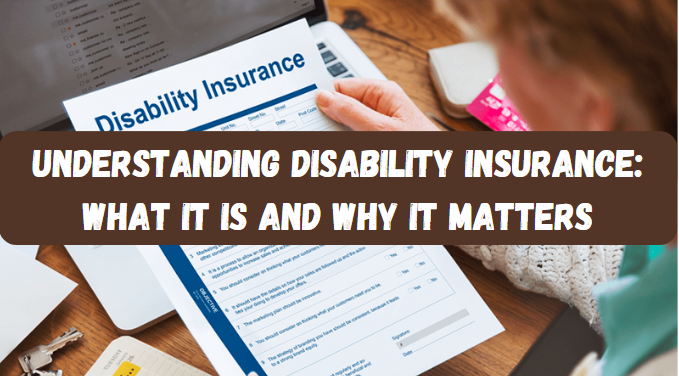Disability insurance is a critical component of financial planning that offers protection against the loss of income due to illness or injury. It can be a lifeline for individuals who are unable to work and earn a living due to a disability. This article explores what disability insurance is, why it matters, and how to choose the right policy to safeguard your financial well-being.
Contents
What is Disability Insurance?
Disability insurance provides income replacement if you become unable to work due to a disability caused by illness or injury. The coverage aims to replace a portion of your lost income, helping you maintain financial stability during periods when you cannot work.
Types of Disability Insurance
- Short-Term Disability Insurance (STDI)
- Coverage Duration: Typically provides benefits for a short period, usually up to six months.
- Eligibility: Often covers temporary disabilities, such as recovery from surgery or a short-term illness.
- Benefits: Generally replaces a portion of your income (e.g., 60-70%) during the covered period.
- Long-Term Disability Insurance (LTDI)
- Coverage Duration: Offers benefits for extended periods, often until retirement age or for the duration of the disability.
- Eligibility: Designed for more severe or prolonged disabilities that prevent you from working for an extended time.
- Benefits: Provides a percentage of your income (e.g., 50-70%) for a longer duration, depending on the policy terms.
How Disability Insurance Works
When you purchase a disability insurance policy, you pay regular premiums to the insurance company. In return, the insurer agrees to provide financial support if you become disabled and are unable to work.
Key Components of a Disability Insurance Policy:
- Premiums: The amount you pay for coverage, which can vary based on factors such as age, occupation, and coverage amount.
- Waiting Period: The period you must wait before benefits begin, known as the elimination period. Short-term policies may have shorter waiting periods, while long-term policies may have longer ones.
- Benefit Amount: The percentage of your income that will be replaced by the policy, typically ranging from 50-70%.
- Benefit Period: The duration for which benefits will be paid, which can be a specific number of years or until retirement age, depending on the policy.
Why Disability Insurance Matters
Disability insurance is essential for several reasons:
Financial Security
If you become unable to work due to a disability, your regular income may stop, but your financial obligations—such as mortgage payments, bills, and daily expenses—continue. Disability insurance helps replace a portion of your lost income, providing financial security and reducing the risk of falling into debt.
Protecting Your Standard of Living
A disability can impact your ability to maintain your standard of living. Disability insurance helps cover your essential expenses, such as housing, food, and healthcare, ensuring that you can continue to live comfortably even while you are unable to work.
Peace of Mind
Knowing that you have a financial safety net in place can provide peace of mind. Disability insurance offers reassurance that you will have some financial support if an unexpected illness or injury prevents you from working.
Coverage Gaps in Other Insurance Policies
Health insurance typically covers medical expenses related to a disability, but it does not replace lost income. Disability insurance fills this gap by providing income replacement, ensuring that you have financial support in addition to medical coverage.
Choosing the Right Disability Insurance Policy
Selecting the right disability insurance policy involves evaluating your needs and understanding the available options. Here are some key considerations:
Assess Your Needs
- Income Replacement: Determine how much income you need to replace if you become disabled. Consider your monthly expenses, including mortgage or rent, utilities, groceries, and other financial obligations.
- Occupation: Assess the risk associated with your occupation. Some jobs have a higher risk of injury or illness, which may influence the type and amount of coverage needed.
Compare Policy Options
- Policy Types: Choose between short-term and long-term disability insurance based on your needs and risk factors.
- Coverage Amount: Compare the percentage of income replacement offered by different policies. Ensure that the coverage amount will adequately meet your financial needs.
- Waiting Period: Evaluate the waiting period or elimination period for each policy. Shorter waiting periods may result in higher premiums, but they provide faster access to benefits.
Review Policy Terms
- Benefit Period: Check the duration for which benefits will be paid. Long-term policies typically offer coverage until retirement age, while short-term policies have a fixed benefit period.
- Exclusions and Limitations: Review the policy’s exclusions and limitations to understand what is and is not covered. Some policies may exclude certain types of disabilities or pre-existing conditions.
Seek Professional Advice
Consult with a financial advisor or insurance agent to help you navigate the options and choose a policy that aligns with your needs and budget. They can provide insights into the best coverage options based on your specific circumstances.
Conclusion
Disability insurance is a vital tool for protecting your financial well-being in the event of an illness or injury that prevents you from working. By understanding the different types of disability insurance, evaluating your needs, and selecting the right policy, you can ensure that you have the necessary coverage to maintain financial stability and peace of mind. Investing in disability insurance is a proactive step toward safeguarding your future and protecting what matters most.






















+ There are no comments
Add yours